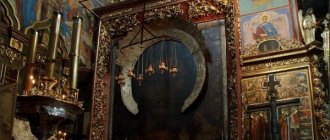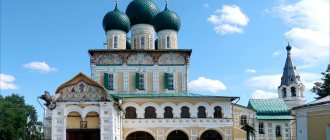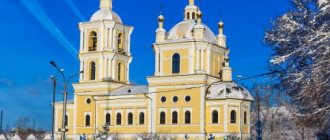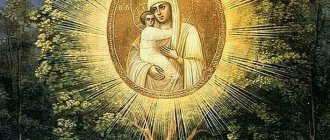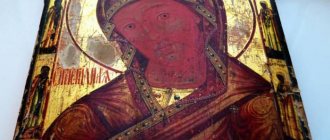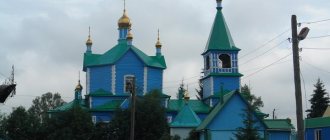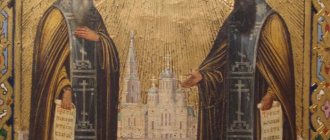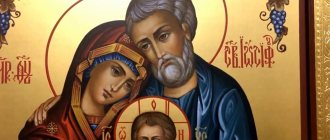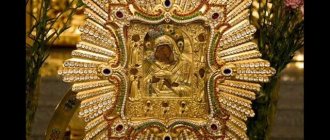The holy image of the icon of the Lord Savior in power is a unique divine image, which is located in almost all Christian churches at the head of the iconostasis. All this is explained by the fact that this shrine plays a very important role for all Christians. The icon includes key events in the history of the formation of Orthodoxy, as they were described by all eminent seers. Next, you will find out in what cases the face of “Savior in Power” helps and its role in the life of Christians.
Dear Brothers and Sisters, we will be very glad if you subscribe to our group on VK, there you will find even more prayers, icons and other interesting information, here is the address link - Orthodox group! Or our Orthodox group in Odnoklassniki! We are also pleased to remind you that on the pages of our church store you can find all possible Orthodox goods!
History of the appearance of the image
Orthodox icons are created based on texts from the Holy Scriptures (Old or New Testament), the life of a saint, or the praise of angels. The name of the image “The Savior is in Power” contains a deep theological meaning, the basis of which was the apostolic revelations (John Chrysostom) and the visions of the Old Testament prophets (Ezekiel, Isaiah).
The Tretyakov Gallery houses two icons of “The Savior in Power,” made by icon painters A. Rublev (in the 14th century) and Dionysius (in the 15th century). Rublev's icon was intended for the Assumption Cathedral in Vladimir. Dionysius painted a sacred image for the Pavlo-Obnorsky monastery (near Vologda). The compositional structure of the icon of Dionysius repeats the image created by Andrei Rublev.
The iconography of “Savior in Power” is inherent only in the Russian school of icon painting, which is explained by the peculiarity of the placement of holy images in the temple. Icon painters began to adhere to the canon developed by Rublev, allowing minor deviations in details.
The veneration of the “Savior in Power” icon occurs on all significant Orthodox holidays, especially on the August Nut, Apple and Honey Savior.
Where to hang the icon of the Savior at home
In the home of Christian believers, holy images must certainly be placed in the red corner of the home. In the case when the red corner is not installed in the home, but still it is not recommended to place the icons near other interior items.
It is not recommended to place the icon on bookcases, as well as in glass cabinet doors, near cosmetics, souvenirs, photographs, paintings and other interior details.
It is strictly forbidden to hang or place icons near colorful posters of famous artists, sports masters, politicians and other idols. Important! The Holy Face is not an “accumulator” of divine mercy. Divine mercy falls on those who ask not from the image, but through it. Grace is given by the Lord to those people who believe in Him. Admiration of an icon without real faith in the Lord, in his powers and with unclean thoughts is meaningless. But sincere faith and hope for support give believers deliverance, help and grace. In addition, you need to realize that an icon is not a talisman, which is characteristic of paganism. It does not miraculously deliver from scandals, troubles, and does not represent a talisman against evil spirits.
The Christian faith guides people through life with God's Word. That is why the images of Jesus are given the most important place in the church iconostasis and at home.
Symbols and their meaning
The conceptual meaning of the image on the icon is the Second Coming of Christ in fulfillment of Divine providence. The meaning of the universe is encrypted in the icon through geometric signs and symbols. The central figure is Jesus Christ sitting on the throne. With his right hand he blesses the believers, and in his left he holds a book.
The main background of the icon is a combination of blue and red. The blue color symbolizes the Divine nature, red – the earthly essence. The robe of the Almighty Creator is designed in the same color scheme: a red tunic and a blue cloak. The red chiton means the materiality of the world created by the Creator, the blue cape means the angelic environment.
An open book implies a multi-valued interpretation of its contents:
- the Book of Life, in which the names of the righteous are entered;
- Book of Revelation;
- Bible;
- Gospel;
- Good News.
The book can be understood as a symbol of God himself. In early Christian images, the Book, onto which a dove flies, personified God (in the beginning there was the Word...).
Jesus Christ is depicted against a red diamond background. The color and shape of the geometric figure mean Divine fire. The Old Testament prophets testified to the appearance of the Lord in fire. Heavenly Fire is a symbol of the Divine.
The rhombus is inscribed in a blue/green circle/oval. This is a world inhabited by disembodied spirits.
It conventionally depicts disembodied spirits, the structure of the heavenly distribution of power and purpose, described by Dionysius the Areopagite. The heavenly army surrounding Jesus Christ is his strength, which is where the name of the icon “Savior in Power” comes from.
The oval is inscribed in a red square, which means earth. The celestial sphere hovers above the earth's firmament and everything that inhabits it. Four corners - four cardinal directions. Under the influence of Divine Love, the earth is transformed.
The Good News spreads throughout the Earth through the sermons of evangelists, symbolically indicated in the corners of the square:
- the face of the angel is Matthew;
- image of a calf - Luke;
- lion - Mark;
- eagle - John.
These animals were described by John the Theologian. They are mentioned in the liturgy as singing (eagle), crying (calf), calling (lion), speaking (angel/man).
The meaning of these terms also has a theological explanation:
- Verb. A person is a creative person who has the ability to create new words that change the world around him.
- Blatant. Taurus/ox/lamb. The power of God is refracted in it when the transition from ethereal peace to creativity occurs. The Lamb humbly dies for the sake of creating the material world and cries out in pain.
- Caller. Leo, the king of beasts, personifies earthly rulers who unite peoples around themselves.
- Singing/flying. The eagle soars above the earth, its energy does not touch the world. A symbolic representation of the energy of God in a state of rest, which will soon be interrupted.
Golden rays emanate from Christ to the corners of the square, not crossing the border of the oval - a symbol of the power emanating from the Creator and holding the Universe in His power.
The image of the Savior on the icon serves as a reminder of the coming Last Judgment, where everyone alive and dead will meet the righteous and true Judge.
Iconography and symbolism of the icon of the Savior in Power
A characteristic feature of this divine image is its rather difficult symbolism, which is not contained in any image included in the iconography of the Almighty. The composition of this icon includes several main symbols: • Our Savior sits on a throne and holds the Holy Scriptures in front of him. Christ's vestment of white and golden flowers symbolizes his innocence and purity, as well as his divine essence; • Behind Jesus is a reddish rectangle with long corners. The rectangle means earthly life. Divine signs are drawn on the corners of the square: the heavenly spirit, the king of beasts, the proud bird eagle and ox, they mean God's saints Matthew, Mark, Luke and John; • The blue circle symbolizes the religion of the whole world; • In this circle are drawn holy spirits, symbolizing heavenly powers. It is believed that this is what gave the image its name; • Above the circle there is a reddish diamond; it is a symbol of the invisibility of the spiritual world.
The uniqueness of the image lies precisely in the arrangement of different geometric figures, which are depicted against the background of Jesus Christ, and symbolizing the two essences of the Son of God: human and divine. This appearance of Jesus is an image of the biblical treatise on the Second Coming of Our Savior, who came to fulfill the Lord’s Order to unite everything divine and worldly into one whole. Dear Friends, we remind you that it is easy to buy an icon of the Savior in Power on our pages!
Prayer text
Oh, holy new martyr and confessor of Russia: saints and shepherds of the Church of Christ, royal passion-bearers, noble princes and princesses, valiant warriors, monastics and worlds, pious men and wives, who suffered for Christ at all ages and classes, who testified to His fidelity even to death and those who have received the crown of life from Him!
During the days of the fierce persecution that befell our land from the godless, at the courts, in captivity and the abysses of the earth, in bitter works and all sorts of sorrowful situations, you courageously showed to nature the image of patience and unashamed hope. Now, enjoying sweetness in paradise, you stand before the Throne of God in glory and offer ever praise and intercession to the Triune God with the Angels and all the saints.
For this reason, we, unworthy, pray to you, our holy relatives: do not forget your earthly fatherland, aggravated by the sin of Cain’s fratricide, the desecration of shrines, atheism and our iniquities. Pray to the Lord Almighty that He may establish His Church unshakable in this rebellious and evil world; may the spirit of brotherly love and peace revive in our land; may we again be the royal priesthood, the race of God, chosen and holy, ever with you glorifying the Father and the Son and the Holy Spirit forever and ever. Amen.
The meaning of the icon of the Savior in Power
The holy image “Savior in Power” is a very famous composition. This icon belongs to the series of icons of the Almighty; the significance of this shrine is explained by its central place in the church iconostasis. As noted above, this icon occupies the main place among the icons in all Christian churches and houses of believers.
This icon has ancient historical roots. For the first time, the holy image of “Savior in Power” appeared around the fourteenth-fifteenth century. The prerequisite for the creation of this image is considered to be a prophecy that was written by the prophet Ezekiel and Hierophanius. This vision was sent by Ivan the Theologian. The composition of the icon is based on gospel treatises that have survived to our time. Jesus holds the Bible in his shuitz (left hand), and with his right hand Jesus bestows blessings on Christians. The Savior is depicted floating in the air, inscribed in a red diamond
The image of the Savior is considered not only an illustration of the Gospel text. It contains a variety of symbols that symbolize divination. The colors used in writing the icon also have their own interpretation: the red square symbolizes the earth, and the blue oval symbolizes heaven.
Description and meaning of the holy image
Jesus Christ is most often portrayed as the good shepherd who saves the sheep, but Christians sometimes forget that the Messiah is part of the Trinity and He will also judge people at the end of time. Therefore, it is important to regularly remember the Messiah in this way in order to have a correct understanding of Him. Today, the most famous icon “Savior in Power” belongs to the brush of Andrei Rublev.
The very name of the image “Savior in Power” expresses the theological concept - the appearance of Jesus Christ in power and glory at the end of time, in fulfillment of Divine Providence for the world: “In order to unite all things earthly and heavenly under the head of Christ.” The manifestation of God's glory is conveyed on the icon in the form of symbolic figures - geometric and isomorphic, they denote various forces of the heavenly, earthly and celestial levels.
In the center is Christ seated on the throne. The red color symbolizes the fiery nature of the deity (“For the Lord your God is a consuming fire.” (Deut. 4.24), the burning bush (Ex. 3.2). Gold-colored clothes symbolize the radiance of glory, white – the purity and purity of the Savior as the sacrificial Lamb .
The background of the icon is filled with geometric shapes: a blue circle (oval) and a red square (rhombus) are superimposed on a red square. The combination of red and blue symbolizes the union in Christ of the divine and human natures of the Savior, the heavenly kingdom and the earthly world, mercy and truth, the fire of the Spirit and Living water, unknowability and incarnation, etc.
It depicts Christ seated on a throne, His feet standing on a special dais, and His left hand holding an open book. With his right hand, the Messiah blesses all people; around the throne you can see all the heavenly forces: an army of angels, whose faces are surrounded by snow-white wings. It is believed that it was the drawing of the heavenly army around Christ that gave the name to the image.
A distinctive feature of this icon is that it has very complex symbolism, unlike the rest of the Pantocrator iconography. The image itself consists of several important elements:
The “Savior is in power” icon has several important elements:
- The image depicts Jesus, who is dressed in white and gold robes. White color is a symbol of purity and innocence. And the gold shows that Jesus is holy.
- The icon “Savior in Power” (a photo of it is presented above for clarity) has an image of a red square. He is located behind Jesus. Its ends have a pointed shape. This square is a symbol of the earth. In its corners are depicted such symbols of the Gospel as the Lion, Taurus, Eagle and Angel. They refer to Saints Matthew, Luke, John, Mark.
- Behind Jesus there is also a blue oval. It is a symbol of spirituality.
- Angels are depicted on a blue background, symbolizing powers. The icon is named in honor of these forces.
- The red diamond, which is drawn on top of the blue background, is a symbol of the world that we cannot see.
The meaning of the “Savior in Power” icon lies in the combination of geometric figures against which Christ is depicted, which are interpreted as a sign that the Son of the Lord has both human and divine qualities. This image of the Savior is a depicted biblical treatise about the Second Coming of the Son of God, who will fulfill the will of the Lord and unite all things heavenly and earthly together.
Why is the image in the center of the iconostasis
The iconostasis is the partition between the walls in front of the altar, which is the central part of the interior. It consists of several rows of images (from row 1 to row 5) and attracts the gaze of all worshipers, covering the altar from them. Placing the iconostasis in this way is an Old Testament tradition; it is a kind of Jewish curtain in the temple that hid the Holy of Holies.
On a note! In an Orthodox church, behind the iconostasis there is an altar in which the clergy pray.
Initially, the iconostasis included 12 images that symbolized the apostles, and at the top there was a cross. Later, the cross was replaced by icons depicting Christ, to whom prayers began to be offered. The row with the icons on which the Messiah was depicted became the main one (Deesis) and was traditionally located in the center.
With the advent of “The Savior in Power”, the development of the ancient Russian iconostasis began, which included festive images (they depict Christian holidays), prophetic and forefathers.
According to the plan of the clergy, the entire iconostasis was supposed to be a picture of the history of mankind, so the expectation of the Messiah, His Crucifixion and the Last Judgment that was coming was captured there. That is why the icon of Christ should always be located in the center of the iconostasis, be it in a church or at home in a red corner.
How to pray correctly
The prayer offered during the celebration of the great days of the Savior has powerful protection. It is allowed to apply for healing from serious illnesses on other twelve holidays, with mandatory attendance at Sunday services. The prayer book contains several prayers that are recommended for reading for this image. Christians have the right to choose for themselves which holy text to recite.
There are no specific rules on how to pray in front of the icon of the Savior. The priests only recommend listening to some advice:
- women must cover their heads with a scarf;
- before the beginning and at the end of the prayer service, you need to make the sign of the cross three times;
- during the period of the great twelve holidays, when making appeals to the Heavenly patrons, bows to the earth are made, on other days - bows;
- It is not necessary to read prayers in church; it is permissible to turn to Jesus Christ in front of the home iconostasis.
Advice! During the prayer to the icon of the Savior, you need to light candles or a lamp; after reading the main text, words of gratitude are offered to Jesus Christ.
Fig. 3 True faith, repentance and heartfelt hope with which a Christian turns to the icon of the Savior in Power will certainly find a response from the Almighty.
Blessings and support from heavenly patrons will always be nearby. You cannot read the text with negative feelings or a desire to harm another person. All prayers are said with sincere faith in the fulfillment of plans and a pure heart. Otherwise, the prayer will not be heard by the Almighty. People who wish evil upon someone when turning to Jesus Christ may soon experience negative changes and troubles. All dark thoughts, envy, violation of biblical commandments are sure to return with the Trinity.
What does an icon help with?
The icon of the Savior in power helps all believers and gives protection from evil spirits to everyone who prays.
The sacred image will protect you from risky, reckless actions and falls, and will help you in difficult life situations, especially when you lose a loved one or discover a serious illness.
The icon will support mental disorders and unstable emotional background, protect against nonsense and promote recovery. In addition, the Savior in power is known for his ability to give a person family well-being, mutual understanding and love.
